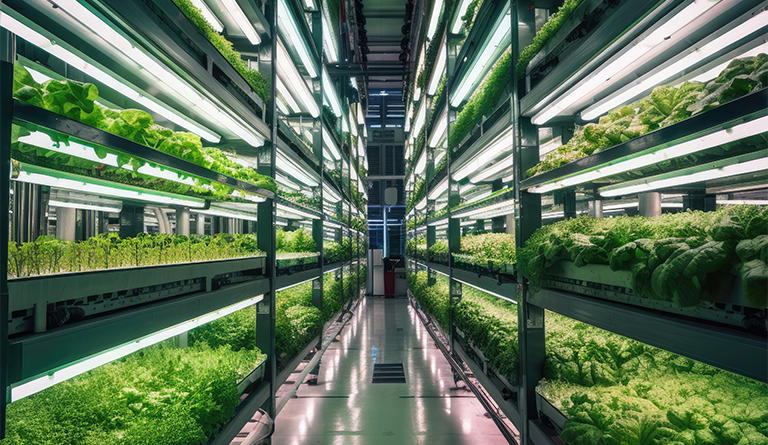Norfolk’s Flat Fields Turn Skyward with Vertical Farms
Vertical farming, a groundbreaking method of agriculture, is rapidly emerging as a solution to the pressing challenges of modern food production. This innovative practice involves growing crops such as rocket, watercress, basil, and chives in stacked layers under controlled conditions. Artificial temperature, light, water, and humidity replicate the ideal growing environment, eliminating variables like weather, pests, and disease.
Fischer Farms in Norwich exemplifies the potential of vertical farming. Producing up to 1,000 tonnes of leafy greens, herbs, and salads daily, this facility demonstrates the scalability and efficiency of vertical farming. According to Tristan Fischer, founder of Fischer Farms, this system can “provide a significant amount of food stability around the world.” The goal is clear: feed the world without further damaging the planet.
Belinda Clarke, director of Agri-TechE, highlights vertical farming’s transformative potential, calling it a “gamechanger for the industry.” However, she notes the difficulties in perfecting the business model, especially the high upfront costs and need for high-value crops. Despite these challenges, the promise of vertical farming continues to attract attention and investment.
The Technology Behind Vertical Farming
The technology driving vertical farming is both sophisticated and innovative. At Fischer Farms, crops are grown in biosecure atmospheres, free from pesticides, herbicides, and insecticides. The process starts with seeds germinated in the dark before being moved to grow under bright lights in a controlled 24°C (75°F) environment. This method ensures optimal growth conditions year-round, independent of external weather factors.
Samantha Woods, a grow assistant at Fischer Farms, explains how the facility emulates natural conditions. “They’re emulating wind and sunshine, so we can have a night cycle for the plants. The wind makes the plants stronger, and the sunshine helps them to grow,” she says. This precise control over environmental factors results in healthier and more robust crops.
The technological setup includes advanced climate control systems and energy-efficient LED lighting, designed to maximize growth while minimizing energy consumption. Fischer Farms also plans to power its operations with energy from a nearby 130-acre solar farm, underscoring the commitment to sustainability.
Vertical farming offers significant economic and environmental benefits. By producing the same amount of food on a four-acre site as a traditional 1,000-acre farm, Fischer Farms showcases the efficiency of this method. This high yield per square meter is crucial in a world facing increasing land scarcity and a growing population.
Environmentally, vertical farming reduces the need for arable land, conserves water, and eliminates the use of harmful chemicals. The controlled environment also means fewer pests and diseases, resulting in lower crop losses. Fischer Farms’ model, funded by private equity firm Gresham House, is among the largest in the world, covering 25,000 square meters.
However, the energy demands of vertical farming cannot be ignored. Dr. Clarke points out that for vertical farming to be commercially viable, it must be located near a sustainable energy source, such as a solar farm or anaerobic digester. Fischer Farms addresses this challenge by utilizing solar panels on its roof and planning future energy needs with the new solar farm next door.
Despite its promise, vertical farming faces several challenges. The initial capital investment is substantial, requiring investors to justify the costs by focusing on high-value crops, such as those for pharmaceuticals, cosmetics, or out-of-season imports. Dr. Clarke notes that growing staple crops like cereals, which thrive under natural sunlight, may be harder to justify economically.
Fischer Farms has been experimenting with growing wheat and plans to expand into fruits, soy, and peas. These trials will help determine the feasibility of vertical farming for a broader range of crops. The industry’s growth hinges on continuous technological advancements and cost reductions to make vertical farming more accessible and profitable.
Looking ahead, the potential for vertical farming is immense. As technology improves and costs decrease, vertical farming could become a cornerstone of global food production, addressing food security and sustainability challenges. The integration of renewable energy sources will further enhance its viability, making it an attractive option for future agricultural practices.
Vertical farming represents a paradigm shift in agriculture, offering a sustainable and efficient alternative to traditional farming methods. Facilities like Fischer Farms illustrate the potential of this innovative approach to produce large quantities of food with minimal environmental impact. While challenges remain, the ongoing investment in technology and renewable energy solutions promises to overcome these barriers.
As the world grapples with climate change and a growing population, vertical farming could play a crucial role in ensuring food security. The ability to grow crops in controlled environments, free from the unpredictability of weather and pests, positions vertical farming as a viable solution for the future of food production. With continued support and innovation, vertical farming can indeed feed the world without trashing the planet.
Sources:
- BBC Article on Vertical Farming
- Scientific American on Vertical Farming
- The Guardian on Urban Agriculture
- Nature on Agricultural Technology
- Bloomberg on Market Potential of Vertical Farming
- MIT Technology Review on Farming Technologies
